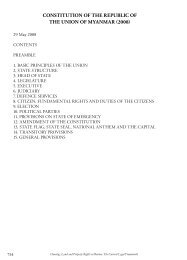Myanmar at the HLP Crossroads: - Displacement Solutions
Myanmar at the HLP Crossroads: - Displacement Solutions
Myanmar at the HLP Crossroads: - Displacement Solutions
Create successful ePaper yourself
Turn your PDF publications into a flip-book with our unique Google optimized e-Paper software.
27<strong>Myanmar</strong> <strong>at</strong> <strong>the</strong> <strong>HLP</strong> <strong>Crossroads</strong>ANNEX 1:6 A Brief Historical Overview of <strong>the</strong><strong>HLP</strong> Legal Framework of <strong>Myanmar</strong>The current legal framework origin<strong>at</strong>es with laws th<strong>at</strong> were put in place during <strong>the</strong> British colonial period, many ofwhich apparently have never been repealed nor necessarily used in practice. (15) Starting with <strong>the</strong> Caste DisabilitiesRemoval Act (1850), which banned laws and practices th<strong>at</strong> impair property rights or impact <strong>the</strong> rights of inheritancebased on religion or caste st<strong>at</strong>us, <strong>the</strong>se laws establish a wide range of <strong>HLP</strong> rights and oblig<strong>at</strong>ions along with administr<strong>at</strong>iveprovisions for implement<strong>at</strong>ion and enforcement. The development of <strong>the</strong> current legal framework can beroughly divided into five periods: <strong>the</strong> colonial era, starting in 1850 and concluding a century l<strong>at</strong>er with Burmese independencein 1948; <strong>the</strong> early years of post-colonial independence, from 1948 to 1962; <strong>the</strong> “socialist” period of militaryrule, from 1962 to 1988; <strong>the</strong> l<strong>at</strong>ter period of military rule from 1988 to 2009; and <strong>the</strong> current period of acceler<strong>at</strong>ingreform and democr<strong>at</strong>iz<strong>at</strong>ion th<strong>at</strong> began in 2009.For over 800 years, from <strong>the</strong> 11th to 19th centuries, <strong>the</strong> people of central Burma lived under an absolute monarchy.During this period, <strong>the</strong> social structure of Burma was expressed in legal texts (dhamm<strong>at</strong>h<strong>at</strong>s) interpreted and appliedby specialist lawyers (shene). The annex<strong>at</strong>ion of Burma by <strong>the</strong> British began in 1825 and continued for <strong>the</strong> next 62years. By 1886, all of Burma was incorpor<strong>at</strong>ed into <strong>the</strong> British Raj and was administered as a province of India. TheBritish implemented complete legal, governmental and administr<strong>at</strong>ive reform. All Burmese law was replaced with<strong>the</strong> <strong>the</strong>n current Anglo-Indian law. The Privy Council was instituted as <strong>the</strong> highest court in Burma and when muchof <strong>the</strong> common law was codified in India, it was similarly adopted in Burma and compiled into <strong>the</strong> 13 volumes of <strong>the</strong>Burma Code. In addition to <strong>the</strong> Burma Code and common law, and akin to <strong>the</strong> policy enacted in British India, respectivereligious laws (Buddhist, Muhammadan and Hindu) were to be retained in <strong>the</strong> area of “succession, inheritance,marriage or caste or any religious institution”. This position was formalised in <strong>the</strong> Burma Laws Act (1898).In 1850, <strong>the</strong> initial Burmese law addressing a component of <strong>HLP</strong> rights was adopted. As <strong>the</strong> first of a series oflaws designed to remove certain discrimin<strong>at</strong>ory results from <strong>the</strong> applic<strong>at</strong>ion of religious laws, <strong>the</strong> Caste DisabilitiesRemoval Act (1850), sought to ensure th<strong>at</strong>: “Any law or usage th<strong>at</strong> inflicts <strong>the</strong> forfeiture of property rights or impairsrights of inheritance by reason of an individual renouncing or having been excluded from <strong>the</strong> communion of any religion,or being deprived of caste, shall cease to be enforced by law”. In 1856, <strong>the</strong> Hindu Widows’ Remarriage Act,ensured th<strong>at</strong> Hindu widows would be capable of contracting a second valid marriage and th<strong>at</strong> <strong>the</strong> offspring of suchmarriages would be considered legitim<strong>at</strong>e and capable of inheriting property. The subsequent Married Women’sProperty Act (1874) provided th<strong>at</strong> <strong>the</strong> wages, earnings and property of a married woman were to be considered hersepar<strong>at</strong>e property. Fur<strong>the</strong>r, a married woman was entitled to effect an insurance policy on her own behalf, independentlyof her husband; maintain a suit for <strong>the</strong> recovery of her separ<strong>at</strong>e property and have <strong>the</strong> same remedies andliabilities, both civil and criminal, as if she was unmarried.Several decades l<strong>at</strong>er, a variety of similar laws were approved. The Hindu Disposition of Property Act (1916)removed “certain disabilities” in <strong>the</strong> disposition of property by Hindus. The Act provided th<strong>at</strong> “no disposition ofproperty by a Hindu, whe<strong>the</strong>r by transfer inter vivos or by will, shall be invalid by reason only th<strong>at</strong> any person forwhose benefit it may have been made was not in existence <strong>at</strong> <strong>the</strong> d<strong>at</strong>e of such disposition”. The Hindu Inheritance(Removal of Disabilities) Act (1928) design<strong>at</strong>ed th<strong>at</strong> no person governed by Hindu law, “shall be excluded frominheritance by reason of any disease, deformity or physical or mental defect”. The Hindu Gains of Learning Act(1930) provided a uniform rule as to <strong>the</strong> rights of a member of a Hindu family to property acquired through meansof <strong>the</strong>ir “learning”. The Specific Relief Act was approved in 1877 to govern <strong>the</strong> law rel<strong>at</strong>ed to specific relief of <strong>the</strong>Courts. The Act covers <strong>the</strong> recovery of possession of property (movable and immovable property); <strong>the</strong> specificperformance of contracts; <strong>the</strong> rectific<strong>at</strong>ion of instruments; <strong>the</strong> recession of contracts; <strong>the</strong> cancell<strong>at</strong>ion of instruments;declar<strong>at</strong>ory decrees; <strong>the</strong> appointment of receivers and <strong>the</strong> enforcement of public duties.(15) The full texts of all <strong>Myanmar</strong> <strong>HLP</strong> laws, both extant and repealed through 2009, can be found in English in Leckie and Simperingham, Housing,Land and Property Rights in Burma: The Current Legal Framework, <strong>Displacement</strong> <strong>Solutions</strong>/<strong>HLP</strong> Institute, 2009.













